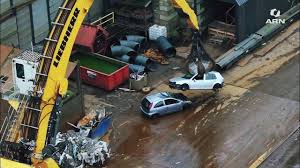When it’s time to say goodbye to your old car, you might wonder what actually happens to it once a recycling or wrecking service picks it up. Many people imagine that their car is crushed into a metal cube and forgotten. However, the truth is far more fascinating and environmentally friendly. Modern vehicle recycling is a high-tech process that carefully dismantles cars, reuses valuable materials, and ensures minimal waste.
In this article, we’ll take you behind the scenes of the auto recycling process and show you how advanced technology is changing the way cars are dismantled and reused in Australia.
The First Step: Collection and Assessment
The recycling journey begins the moment your old or unwanted car is collected. Whether it’s towed from your driveway or dropped off at a wrecking yard, each vehicle is carefully assessed to determine its value and the condition of its parts.
At this stage, car recyclers identify which components can be reused, repaired, or resold. For example, engines, transmissions, alternators, and radiators often have a second life in other vehicles. Tyres, batteries, and catalytic converters also hold significant value because they contain materials that can be recycled or refurbished.
For many Australians, this process starts when they sell their car to a service like Cash for Cars Logan, which specialises in buying unwanted vehicles for recycling and reuse. These services make it easier for car owners to dispose of their vehicles responsibly while earning instant cash.
Step Two: Depollution – Protecting the Environment
Before a car can be dismantled, it must be made safe for the environment. This stage, known as depollution, is one of the most important parts of auto recycling.
Depollution involves draining and safely removing all hazardous fluids and materials from the vehicle. This includes:
- Engine oil
- Transmission fluid
- Brake and clutch fluids
- Coolant
- Air conditioning gases
- Petrol or diesel
These substances can be harmful if released into the environment, so recyclers use specialised equipment to collect and store them properly. The recovered fluids are often refined and reused, while toxic chemicals are sent for safe disposal in accordance with strict environmental regulations.
By doing this, recycling centres ensure that the dismantling process has minimal impact on the planet and local ecosystems.
Step Three: Dismantling and Sorting
Once depollution is complete, the car moves to the dismantling bay. Skilled technicians, supported by advanced tools and technology, carefully take the vehicle apart piece by piece.
During this stage, reusable parts are removed and catalogued. These might include:
- Engines and gearboxes – tested, cleaned, and resold
- Doors, panels, and mirrors – refurbished for use in other vehicles
- Seats and interiors – recycled or reupholstered
- Electronics – such as sensors, GPS systems, and switches
Each part is inspected to determine its condition. Components that are still in good working order are resold as second-hand parts, helping other car owners find affordable replacements.
This process is not only efficient but also sustainable. Reusing parts reduces the demand for new manufacturing, saving energy and resources.
Step Four: Shredding and Material Separation
After all reusable components have been removed, the remaining car shell – mostly metal – is sent to a high-powered shredder. These massive machines can crush and shred entire car bodies into small pieces in a matter of seconds.
Once shredded, the material is fed into an advanced separation system. Here’s how it works:
- Magnets extract ferrous metals such as steel and iron.
- Eddy current separators separate non-ferrous metals such as aluminium and copper.
- Air classifiers and vibrating screens separate plastics, glass, and foam.
The result is a range of pure material streams that can be recycled into new products. For example, steel from old cars is melted down and used to make construction beams, new vehicles, and appliances. Aluminium parts are reprocessed to create cans, wheels, or aircraft components.
This stage ensures that almost 95% of a car’s materials are recovered and reused, drastically reducing landfill waste.
Step Five: Recycling Plastics, Glass, and Tyres
Cars aren’t just made of metal. Modern vehicles contain large amounts of plastic, rubber, and glass, all of which can be recycled.
- Plastic parts, such as bumpers and dashboards, are shredded, melted, and turned into pellets that can be reused in new car components or household goods.
- Glass from windows and windscreens is crushed and processed to remove impurities. It’s then transformed into new glass products or used as a substitute for sand in construction materials.
- Tyres are among the most challenging components to recycle, but new technology enables them to be repurposed into road surfaces, playground materials, or fuel for industrial kilns.
By recycling these materials, auto dismantlers help keep harmful waste out of landfills and contribute to a more circular economy.
Step Six: The Role of Technology in Modern Auto Dismantling
Today’s auto recycling industry relies heavily on technology to make dismantling faster, safer, and more efficient.
Some of the key technologies include:
- Automated depollution systems that precisely drain fluids without spills.
- 3D scanning and digital part databases to track and catalogue reusable components.
- Robotic dismantling arms that help separate materials more accurately.
- AI-powered sorting systems that use sensors and cameras to identify different materials.
These innovations reduce human error, speed up the recycling process, and ensure that more materials are recovered. They also make it easier for recycling centres to meet Australia’s strict environmental standards.
The Environmental Impact of Car Recycling
Car recycling has a major positive impact on the environment. By reusing and repurposing materials, we can significantly reduce pollution, save energy, and limit the need for mining raw materials.
Here are a few key benefits:
- Energy savings: Recycling metals uses up to 75% less energy than producing them from raw ore.
- Reduced emissions: Fewer greenhouse gases are released during recycling compared to manufacturing new materials.
- Less landfill waste: Almost every part of a car can be reused or recycled, reducing the amount of waste sent to landfills.
- Resource conservation: Recycling keeps valuable materials like steel, aluminium, and copper in use for future generations.
When you recycle your old car, you’re not just clearing space or earning money—you’re also helping the planet.
The Final Stage: Rebirth of Recycled Materials
After the car has been completely dismantled, the recovered materials are used by various manufacturing industries. This is where the rebirth happens.
- Recycled steel might end up in new vehicles, buildings, or even bridges.
- Aluminium could be turned into new wheels or beverage cans.
- Reclaimed plastics and rubber might find a second life in furniture, flooring, or insulation materials.
Every recycled car contributes to a cycle of reuse that keeps valuable resources in circulation and reduces environmental harm.
Conclusion: A Smart, Sustainable Future
The next time you decide to recycle your car, remember that it’s not the end of its journey—it’s a new beginning. Through advanced dismantling and recycling technology, old vehicles are transformed into useful materials that continue to power modern life.
From depollution and dismantling to shredding and material recovery, every step in the process plays an important role in protecting our planet. Choosing responsible recyclers and services ensures your vehicle is handled safely and sustainably.
By understanding what happens behind the scenes, you can appreciate how far the auto recycling industry has come—and how your decision to recycle makes a real difference.


